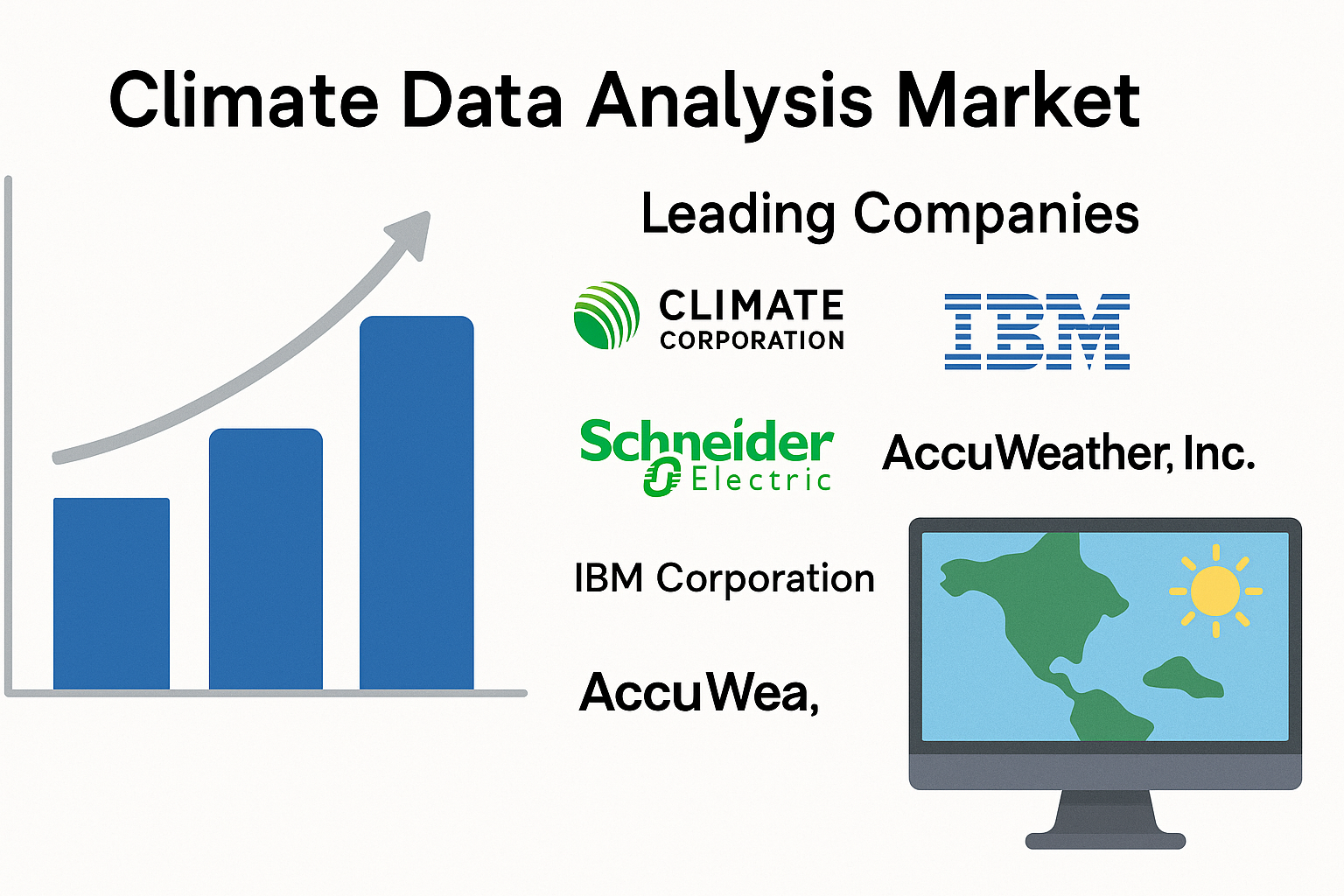Climate Data Analysis Market Under the Spotlight
The Climate Data Analysis Market size is emerging as a cornerstone in climate mitigation, policy formulation, and risk management. With climate patterns growing increasingly erratic, the need for high-resolution, real-time climate data interpretation has surged, prompting stakeholders across government, energy, agriculture, and finance sectors to adopt sophisticated analysis tools. As global temperatures rise and climate risk intensifies, the demand for climate data analytics is set to transform environmental decision-making across the board.
Market Estimation and Definition
The climate data analysis market comprises services and tools used to collect, process, model, and visualize vast environmental datasets—ranging from atmospheric temperature to greenhouse gas levels. These tools help users understand climate trends, predict extreme weather events, plan renewable energy usage, and meet sustainability targets.
In 2023, the global market was valued at 860 Million. With growing investment, technological advancement, and regulatory pressure, the market is forecast to expand at a CAGR of 32%, reaching an estimated USD 5990 Million by 2030.
Key Growth Drivers & Emerging Opportunities
1. Climate Emergency and Risk Awareness
The rising incidence of natural disasters—such as floods, heatwaves, and wildfires—has catalyzed a global focus on resilience planning. Climate data analytics offers vital tools for predicting and preparing for such events.
2. Regulatory Push and Sustainability Mandates
Governments and international bodies are mandating stricter climate reporting and emissions tracking. From the EU’s climate disclosures to global carbon market frameworks, compliance is driving data demand.
3. Technology Integration and AI Innovation
Advances in satellite imaging, AI-powered forecasting models, and cloud computing allow for real-time climate modeling and predictive analytics, unlocking new efficiency in weather forecasting and scenario planning.
4. Corporate ESG Investment
Financial institutions and Fortune 500 companies are embedding climate data into Environmental, Social, and Governance (ESG) strategies to assess long-term physical and transition risks.
Segmentation Analysis
By Data Source
-
Ground-Based Data: Weather stations and field sensors provide highly localized environmental readings.
-
Satellite Data: Offers broader regional and global datasets, key for tracking atmospheric and oceanic patterns.
-
Simulation Models: Climate reanalysis datasets integrate historical observations with model output to simulate past and future conditions.
By Tool Type
-
Statistical Tools: Analyze trends and correlations across time series.
-
Geospatial & Visualization Tools: Transform raw climate data into maps and visual insights.
-
Forecasting Models: Generate medium- and long-term predictions using climate physics.
By Application
-
Weather Forecasting: A dominant segment, used across transportation, agriculture, and energy.
-
Climate Research: Academic and institutional users apply models to evaluate climate change.
-
Disaster Risk Management: Helps governments and insurers plan for extreme events.
-
Urban & Infrastructure Planning: Municipalities use climate insights to design resilient infrastructure.
-
Renewable Energy Management: Wind and solar operators rely on forecasting tools to optimize energy output.
By End User
-
Government & Public Sector
-
Research Institutions
-
Agriculture & Natural Resources
-
Insurance & Finance
-
Energy and Utilities
-
Transport & Logistics
Country-Level Analysis
United States & Canada
Lead the market with advanced weather agencies (e.g., NOAA) and robust climate tech investments. Smart cities and infrastructure resilience plans are key contributors to demand.
United Kingdom, Germany & France
Prominent European nations adopt stringent climate regulations and have strong academic institutions contributing to climate model development.
China & India
Fastest-growing users, driven by urbanization, agricultural dependency on weather, and public-private climate initiatives.
Japan & Australia
Investing heavily in renewable energy and climate adaptation technologies, supported by sophisticated government modeling frameworks.
Latin America, Middle East & Africa
Emerging markets for climate data services as they face disproportionate impacts of climate change. Governments are increasing investments in early warning systems and disaster preparedness.
Competitor Landscape
Several prominent companies are shaping the competitive climate data analytics landscape:
-
IBM Corporation
Offers AI-integrated climate modeling tools for enterprise applications, emphasizing climate risk in financial portfolios. -
Schneider Electric
Focuses on sustainability data integration for smart buildings and infrastructure. -
Verisk Analytics
Specializes in climate risk modeling for insurance and reinsurance markets. -
MSCI Inc.
Provides ESG-based climate analytics for investors, focusing on physical and transitional climate risks. -
ESRI (Environmental Systems Research Institute)
Delivers GIS-driven climate visualization tools used widely in urban planning and research. -
AccuWeather, The Climate Corporation, and Vaisala
Offer commercial-scale forecasting services, sensor technologies, and API-driven data access for agricultural and aviation sectors. -
Jupiter Intelligence and Earth Networks
Deliver high-resolution, enterprise-grade climate models and predictive tools.
In addition, international institutions such as NASA, Copernicus (EU), and Meteo-France play pivotal roles in open-source data contribution and modeling infrastructure.
Conclusion
As global stakeholders brace for escalating climate impacts, the climate data analysis market has become indispensable. With the market poised to jump, organizations across sectors must leverage advanced climate intelligence to remain resilient and sustainable. Whether it’s insurers calculating flood risks or governments preparing for heatwaves, climate data is fast becoming the bedrock of strategic planning in the 21st century. The coming decade promises both vast opportunity and essential responsibility for those innovating in this dynamic and impactful domain.



